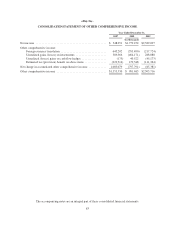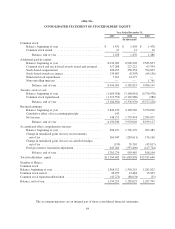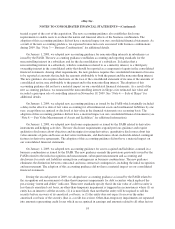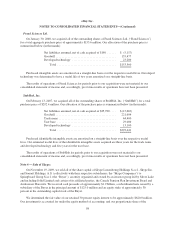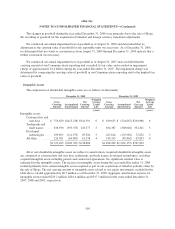eBay 2009 Annual Report Download - page 100
Download and view the complete annual report
Please find page 100 of the 2009 eBay annual report below. You can navigate through the pages in the report by either clicking on the pages listed below, or by using the keyword search tool below to find specific information within the annual report.eBay Inc.
NOTES TO CONSOLIDATED FINANCIAL STATEMENTS—(Continued)
Advertising expense
We expense the costs of producing advertisements at the time production occurs and expense the cost of
communicating advertising in the period during which the advertising space or airtime is used as sales and
marketing expense. Internet advertising expenses are recognized based on the terms of the individual agreements,
which is generally over the greater of the ratio of the number of impressions delivered over the total number of
contracted impressions, pay-per-click, or on a straight-line basis over the term of the contract. Advertising
expense totaled $1.0 billion, $923.4 million and $799.9 million for the years ended December 31, 2007, 2008 and
2009, respectively.
Stock-based compensation
We typically issue two types of stock-based awards: restricted stock units (including performance-based
restricted stock units) and stock options. We determine compensation expense associated with restricted stock
units based on the fair value of our common stock on the date of grant. We determine compensation expense
associated with stock options based on the estimated grant date fair value method using the Black-Scholes
valuation model. We generally recognize compensation expense using a straight-line amortization method over
their respective vesting period for awards that are ultimately expected to vest. Accordingly, stock-based
compensation for 2007, 2008 and 2009 has been reduced for estimated forfeitures. When estimating forfeitures,
we consider voluntary termination behaviors as well as trends of actual option forfeitures. We recognize a benefit
from stock-based compensation in equity if an incremental tax benefit is realized by following the ordering
provisions of the tax law. In addition, we account for the indirect effects of stock-based compensation on the
research tax credit and the foreign tax credit through the income statement.
Income taxes
We account for income taxes using an asset and liability approach, which requires the recognition of taxes
payable or refundable for the current year and deferred tax liabilities and assets for the future tax consequences of
events that have been recognized in our financial statements or tax returns. The measurement of current and
deferred tax assets and liabilities is based on provisions of enacted tax laws; the effects of future changes in tax
laws or rates are not anticipated. If necessary, the measurement of deferred tax assets is reduced by the amount of
any tax benefits that are not expected to be realized based on available evidence.
We report a liability for unrecognized tax benefits resulting from uncertain tax positions taken or expected
to be taken in a tax return. We recognize interest and penalties, if any, related to unrecognized tax benefits in
income tax expense.
Recent accounting pronouncements
On January 1, 2009, we adopted new accounting guidance for business combinations as issued by the
Financial Accounting Standards Board (FASB). The new accounting guidance establishes principles and
requirements for how an acquirer in a business combination recognizes and measures in its financial statements
the identifiable assets acquired, liabilities assumed, and any noncontrolling interests in the acquiree, as well as
the goodwill acquired. Significant changes from previous guidance resulting from this new guidance include the
expansion of the definitions of a “business” and a “business combination.” For all business combinations
(whether partial, full or step acquisitions), the acquirer will record 100% of all assets and liabilities of the
acquired business, including goodwill, generally at their fair values; contingent consideration will be recognized
at its fair value on the acquisition date and; for certain arrangements, changes in fair value will be recognized in
earnings until settlement; and acquisition-related transaction and restructuring costs will be expensed rather than
92



